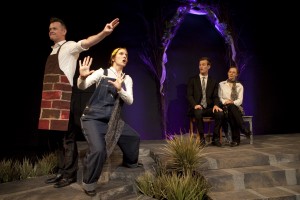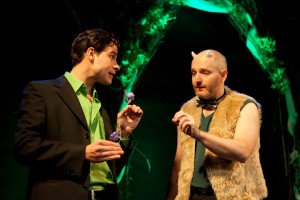According to the old adage, “love is blind” – so goes the premise behind Shakespeare’s classic play, A Midsummer Night’s Dream. The Titan Theatre Company’s production expands this idea with the concept of a sort of “blind” casting – that is, having eight of the nine actors’ roles chosen for them by the audience before every performance. Through this method, the notion of love as something that does not discriminate is quite literally put on display and brought to the forefront in ways possibly never before seen with the play. The results, with the company’s talented cast, is a romantic comedy like no other.
For the uninitiated, A Midsummer Night’s Dream tells the tale of a group of young lovers, a pair of which – Theseus, duke of Athens and Hippolyta, queen of the Amazons – are about to embark on their upcoming nuptials. The rest of the lovers find themselves in a love triangle (or perhaps, a love square), as Demetrius pines for Hermia, who is betrothed to Lysander, while Helena yearns for Demetrius’ affections herself. In the midst of all this, a play is scheduled for the wedding celebrations by a group of simpletons: Quince, a carpenter; Flute, a bellows-mender; Snout, a tinker; Snug, a joiner; and Bottom, a weaver. Rounding out this eccentric cast of characters are the creatures of the wooded forests in which much of the action takes place: Puck (also called Robin Goodfellow), a mischievous hobgoblin; his master of sorts, Oberon, king of the fairies; his queen, Titania; and her attendant, Peaseblossom.
It is through Oberon and Titania’s quarrel over the possession of an orphan boy that the plot thickens, as the Fairy King orders Puck to use a flower with magical properties in order to make Titania fall in love with a beast, so as to pluck the orphan from her ownership while she’s in her daze. The two conspirers also happen to witness Helena pursuing Demetrius in the woods, and Oberon orders Puck to cast Demetrius under the spell of the charmed flower. However, while the task of distracting Titania is successfully done (as she falls for Bottom, turned into a donkey after the group’s rehearsal in the woods), Oberon discovers that Puck has mistakenly made Lysander, not Demetrius, fall in love with Helena. So ensues madness of comedic proportions.
Shakespearean actors are often lauded not only for their ability to decipher and interpret the Bard’s language, but also for their sheer ability alone. They are often classically trained, and as such are able to embody these characters and present them to a modern audience with ease and grace. The cast of this production is no exception – in fact, they far exceed all the usual qualities of a Shakespearean actor, given the task thrown at them. The unique casting process challenges each of the eight actors (the character of Puck is always played by the same actor; in this case, by Matthew Foster) to memorize all 16 roles in the play.
While confusing at first, as some of the female roles were played by men and vice versa, switching things up with the casting only helped to further heighten the comedy and eventually made for a great night at the theater. Each actor was given a track of double roles, and each one was astounding in their grasp of each character. Jonathan Matthew Finnegan was wonderfully flamboyant and ever as the scorned lover of Helena (he also played fairy Peaseblossom), while Sean Hudock was adorable in his roles as the romantic Hermia and shy, cowardly Snug. Though perfectly capable as Lysander, it was Lloyd Mulvey’s take on Flute that garnered much laughter, particularly during the “Pyramus and Thisbe” scene. One of the production’s taglines was: Who’s your bottom tonight? – and this night’s Bottom, played by Emily Trask, was the highlight of the evening, as she managed not only to make the audience cry with laughter, but also induce chuckles from her fellow cast mates.
The casting process also gave way to an interesting reinterpretation of the costumes. As no one knew beforehand which roles they were to play, the cast was first introduced to us wearing “uniforms” of white dress shirts and black slacks. Once cast in their roles for the night, their individual costumes were adjusted, with the women wearing skirts and sashes, and the men wearing sweaters and blazers over their outfits. For the lovers, costume designer Scott Frost had each pair wearing corresponding colors, a clever way for the audience to figure out whose true love belongs to whom.
As for the set design, the production went for a minimal yet elegant set befitting a fantastical play such as this, featuring a simple stone-like platform, replete with bits of shrubbery. Alan Pietrowicz’s lighting, most of which consisted of a neon-colored fixture along the back wall (which would change color depending on the scene), as well as overhead lighting, which would dim in order to signify the transition from day into night and therefore setting the tone for the lovers’ trysts in the forest.
The Titan Theatre Company’s rendition of A Midsummer Night's Dream is one that will leave you entranced and thoroughly entertained. With a clever reimagining and talented cast, this is one dream you won’t want to wake up from.
A Midsummer Night's Dream is playing at The Secret Theatre (4402 23rd Street in Long Island City) until November 3, 2013.



